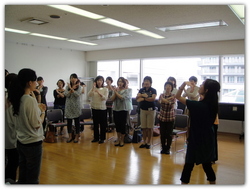 We are thankful that we had another fruitful workshop with many enthusiastic teachers at our recent Study Group Meeting.
We are thankful that we had another fruitful workshop with many enthusiastic teachers at our recent Study Group Meeting.
The topics for this meeting were how to teach the present tense with, “What do you do every day?” and “Do you ~ every day?” We also discussed how to arrange activities to suit the students’ ages, class size and the classroom environment.
We started off with an active warm-up song, “What Do You Do Every Day” to the tune of “The Mulberry Bush.” It is fun and also useful to think of new verses for a song to fit the target sentence of your lessons. So please try it yourself and encourage your students as well to write new verses. (Picture: WU Song)
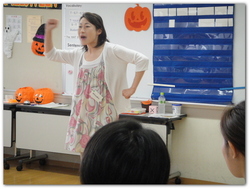 With Practice Key 1, we practiced the basic steps of the MAT METHOD. At the very beginning, we introduced the target sentence with a real container of yogurt and a bottle of water as the teacher said “I eat yogurt every day. I drink water every day.” The students had to listen and think and guess what was said. These small experiences of guessing from the context will gradually build up the students’ comprehension ability.
With Practice Key 1, we practiced the basic steps of the MAT METHOD. At the very beginning, we introduced the target sentence with a real container of yogurt and a bottle of water as the teacher said “I eat yogurt every day. I drink water every day.” The students had to listen and think and guess what was said. These small experiences of guessing from the context will gradually build up the students’ comprehension ability.
After raising the interest of what they are to learn, we can start the first step of the MAT Practice System; teaching the vocabulary. When we first introduce a new word, we need to be careful with the students’ pronunciation. There are sounds in English which do not exist in Japanese such as the /th/ sound in “take a bath”. We need to show them how those sounds can be produced. Then we go through the steps of the MAT METHOD to the very exciting 6-second DRILL which students learn and enjoy at the same time. It’s important to keep the rhythm and speed to maintain the student’s concentration. It also enables the students to practice saying the language many times in a short time. What makes is possible is the special way of holding the cards and shuffling them. We hear some teachers find it difficult. But this technique is essential for the students to learn better. Practice makes perfect!!! Let’s try!!!
(Picture: PK1 intro 2)
Then we always have the corner called “It’s your turn”, where the attendees take turns to be the teacher and practice the steps. Some teachers say that it is much more difficult to do than it seemed to be or that they have hard time trying to remember the steps. But don’t worry. If you stand in front of a mirror and practice, it will become easy.
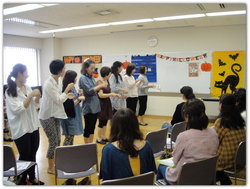 In order to reinforce what the students have learned, we do Learning Activities which students will have more chance to practice saying the language in a short time. Actually we introduced three activities here. We also demonstrated how the same activity can be arranged to suit the students’ ages and class size. It is important to think of the physical and mental development of the students. A 3-year-old has just started to recognize others and learn to relate to them. Thus it might be better for them to do an activity where they need to cooperate rather than to compete with each other. On the other hand, older children might get bored with a simple and easy task. Therefore there has to be something that stimulates their intellectual curiosity so that they will find the activity challenging. The class size and the classroom environment must be taken into consideration as well. We hope that we were able to show some examples of how this can be achieved. (Picture: PK1 Activity)
In order to reinforce what the students have learned, we do Learning Activities which students will have more chance to practice saying the language in a short time. Actually we introduced three activities here. We also demonstrated how the same activity can be arranged to suit the students’ ages and class size. It is important to think of the physical and mental development of the students. A 3-year-old has just started to recognize others and learn to relate to them. Thus it might be better for them to do an activity where they need to cooperate rather than to compete with each other. On the other hand, older children might get bored with a simple and easy task. Therefore there has to be something that stimulates their intellectual curiosity so that they will find the activity challenging. The class size and the classroom environment must be taken into consideration as well. We hope that we were able to show some examples of how this can be achieved. (Picture: PK1 Activity)
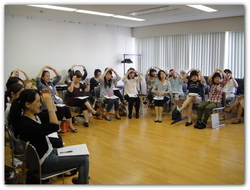 With Practice Key 2, we demonstrated how a “Yes/No Question” can be taught. First the students are taught how to answer with “Yes”. Then the question form is taught. The answers with “No” will be taught after the students are able to do the Question and Yes- answer sequence correctly. With the MAT METHOD, only one new thing is taught at a time. Thus we can avoid learning gaps. We believe this is a very important philosophy of the MAT METHOD. (Picture: PK2)
With Practice Key 2, we demonstrated how a “Yes/No Question” can be taught. First the students are taught how to answer with “Yes”. Then the question form is taught. The answers with “No” will be taught after the students are able to do the Question and Yes- answer sequence correctly. With the MAT METHOD, only one new thing is taught at a time. Thus we can avoid learning gaps. We believe this is a very important philosophy of the MAT METHOD. (Picture: PK2)
In the latter part of the meeting, we had fun listening to a story and doing Halloween activities and making an easy craft.
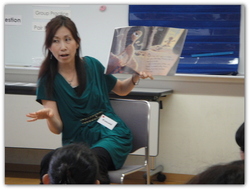 The story of a boy mummy, who did not want to go to bed was so cute. Mother mummy lets him hide and seek for the very last time. Many strange noises are heard, but he insists that he is not scared until at the very end when he sees a “????” We all really enjoyed the book, ” Where Is My Mummy?”
The story of a boy mummy, who did not want to go to bed was so cute. Mother mummy lets him hide and seek for the very last time. Many strange noises are heard, but he insists that he is not scared until at the very end when he sees a “????” We all really enjoyed the book, ” Where Is My Mummy?”
(Picture: Story Telling 2)
Then we sang songs and chants and did Halloween Activities. Here again we introduced various activities so that young students will have fun and older children will enjoy reading.
This is one of the activities we did.
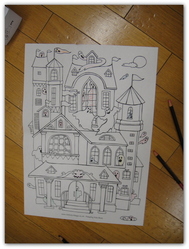 【 Coloring Ghosts 】
【 Coloring Ghosts 】
Level: Kindergarteners and lower graders, beginners
Materials:
- die (colors -red, yellow, blue, pink, green, orange)
- die (number 1-3)
- worksheet “Haunted House with ghosts”
Downloaded from “Activity Village“
- timer
- a set of colored pencils for each team
Object: To practice colors and numbers.
Language: Color three ghosts yellow.
How to play:
1. Enlarge the worksheet to A3 size.
2. Give the sheet to each team.
3. The first player throws 2 dice (a color die and a number one).
4. The others tell the player “Color three ghosts yellow.”
5. The player picks up a yellow pencil and colors three ghosts in the sheet.
6. Take turns and do the same.
7. See how many ghosts they can color in 3 minutes.
We hope that the skills and the ideas we shared will help you and your students to enjoy the lesson.
We hope you have a fun Halloween with your students!!
Happy Halloween and see you again at our next meeting!!!